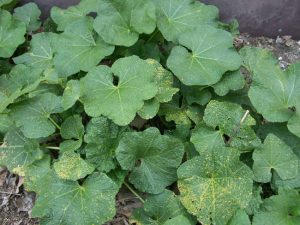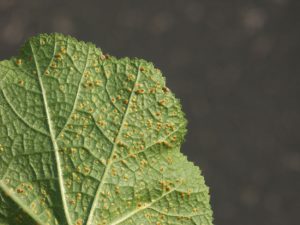
Early symptoms of hollyhock rust
Photo Credits: Dan Egel, Purdue Dept. of Plant Pathology
Q. The last three years I have had scale on my hollyhocks. They just start to bloom, and the scale appears and they die. Is there something I can use to get rid of the scale? After they start to die, I clean up everything and burn. – I.T., Paoli, Indiana.

Close-up of young rust pustules on the underside of a hollyhock leaf. Spores develop in pustules and will spew forth when pustules erupt.
A. I wonder if you might be referring to hollyhock rust, a fungal disease that commonly affects hollyhocks. The rust-colored blotches can resemble scale insects. The disease is particularly prevalent in damp or humid weather, starting as small spots that quickly enlarge and spread to other leaves and stems. While plants may not be killed by rust, they will be quite unsightly.The fungus overwinters in infected plant material, so cleaning up the garden is critical to reducing future problems. Pruning out infected plant tissue will also help reduce the spread. Some fungicides that contain chlorothalonil, mancozeb or sulfur are labeled for use in controlling hollyhock rust. However, keep in mind that fungicides are preventative, not curative. They can only protect healthy foliage from becoming infected. If the plant is heavily diseased, it is too late to apply fungicides. Always consult the label for recommended rates and safety information before you apply. More information on disease resistant ornamentals is available at https://www.extension.purdue.edu/extmedia/bp/id-414-w.pdf.
Q. I have been reading about the benefits of Epsom salts in gardening. One site suggested foliar feeding with Epsom salts during watering cycles and stated that the magnesium would help with the uptake of calcium into the plant. Epsom salts are so inexpensive. I am going to experiment with it this year. – D.D.
A. Epsom salts are magnesium sulfate and can be beneficial to garden crops if your soils are deficient in either magnesium or sulfur. Foliar feeding is useful in testing to see if there is a plant response but, in general, is not the most efficient way to apply fertilizer. Most soils have sufficient supplies of both. Some sandy soils and other soils exposed to excessive rainfall/irrigation can be deficient in magnesium, and, in this case, Epsom salts can be a good source. Sulfur deficiency used to be rare in our Indiana soils but appears to be an issue in some areas. However, applying any fertilizer when there is no need is not likely to be helpful and could be harmful by causing nutrient imbalance and excessive salt accumulation leading to root injury and damage to soil structure. Excessive fertilizer also contributes to pollution of our water stream. The interaction between calcium and magnesium depends on several factors, but, in general, it is more likely that calcium will actually interfere with magnesium uptake. So first order of business would be to have your soil tested to determine what nutrients might be in need. Additional information on collecting soil samples atwww.hort.purdue.edu/ext/HO-71.pdf.
Q. We hooked up to a grinder pump sewer in May of 2013. How long do we have to wait to plant a vegetable garden, and how far should we be from our old septic field. – J.G., Monticello, Indiana.
A. The answer to this question is murky, with many factors to consider. The safest answer is to stay as far away from the old septic field as is feasible. Soil type and condition as well as existing vegetation will greatly affect the ability of that soil to filter the effluent. A properly operating system should not contaminate the soil with disease-causing organisms, but it is difficult to know if the field was operating properly. While two years should be sufficient for any issues to be resolved, it would be safest to plant turf or ornamentals in the immediate area and locate the vegetable garden a bit further away. Root vegetables followed by leafy vegetables would be the must vulnerable to contamination. Fruiting vegetables such as tomatoes, peppers and squash would be less vulnerable, but thoroughly wash produce before consuming.